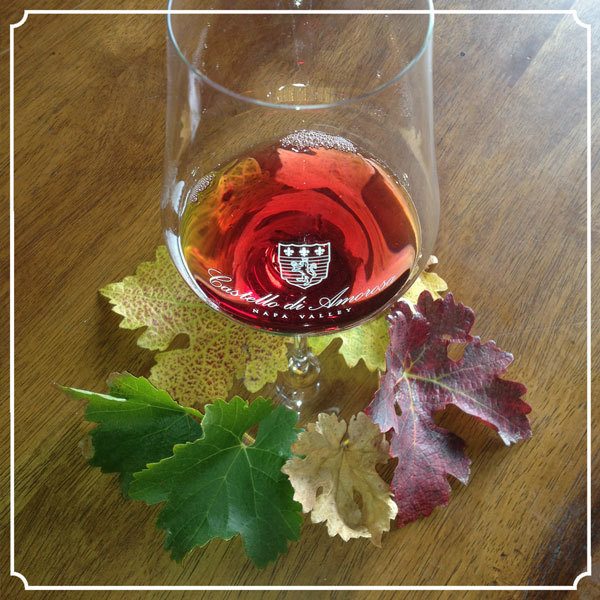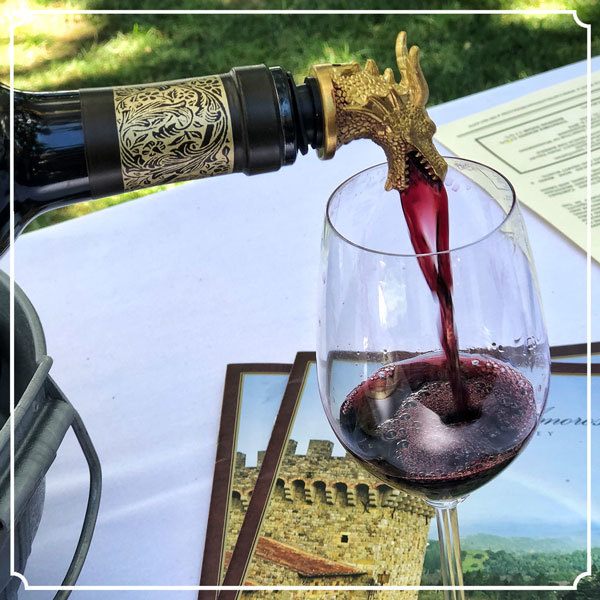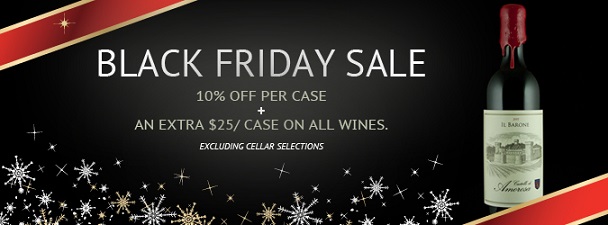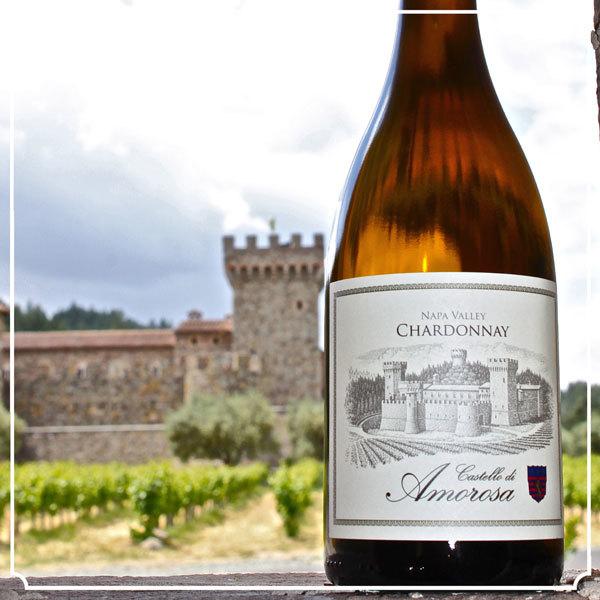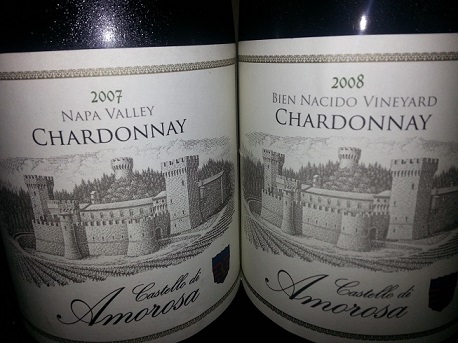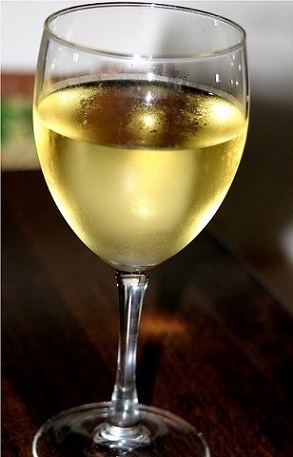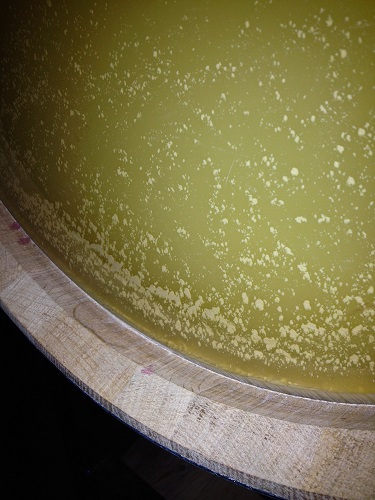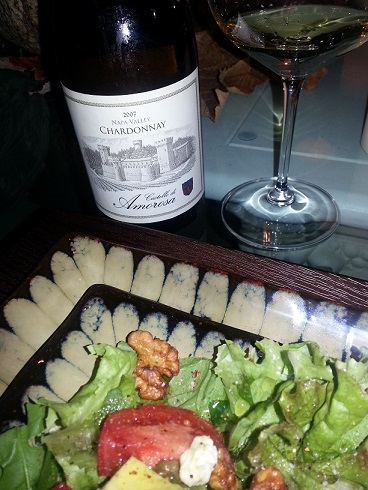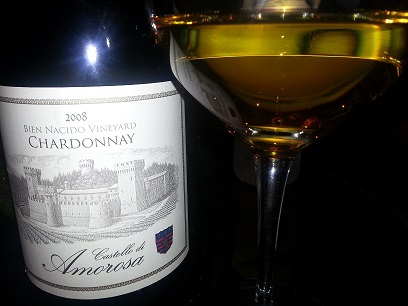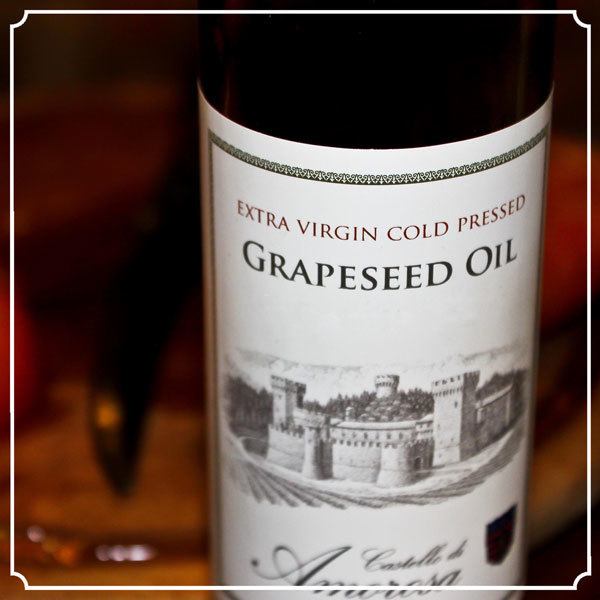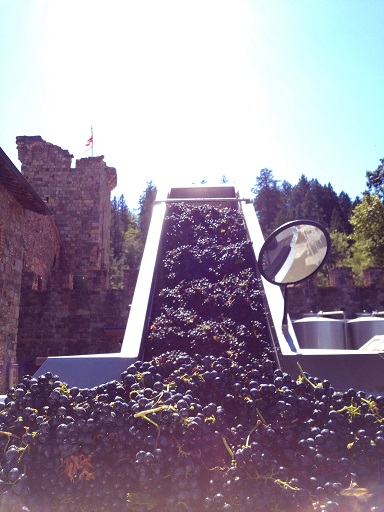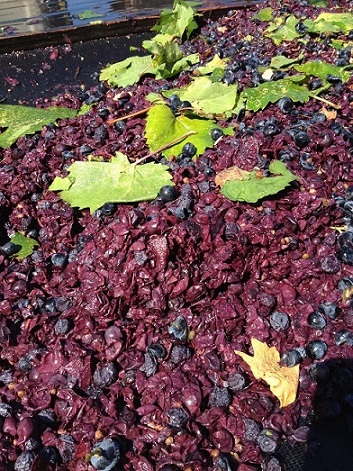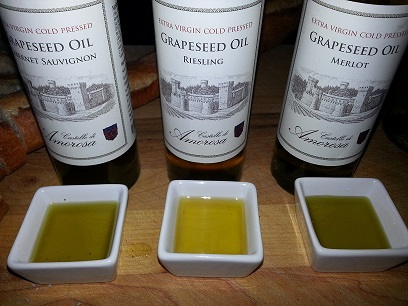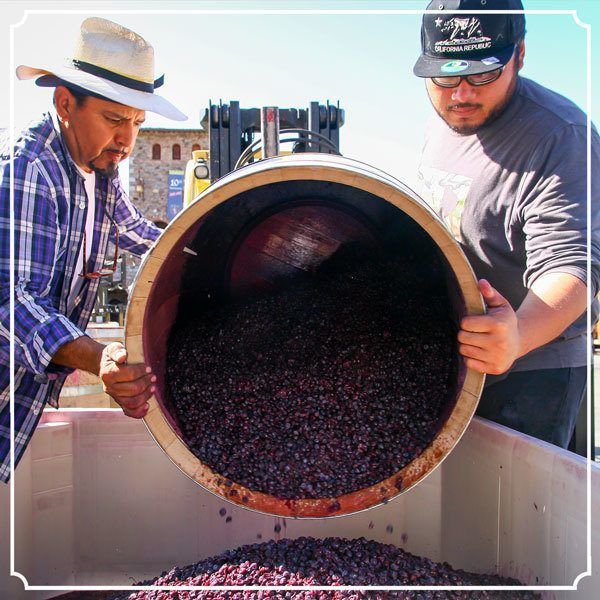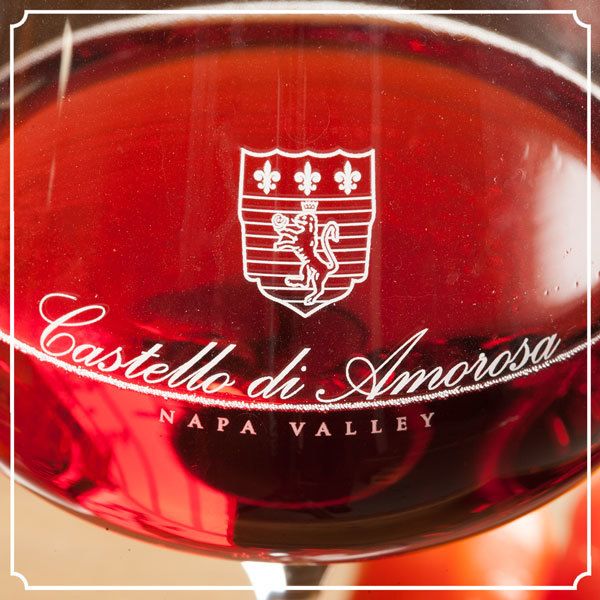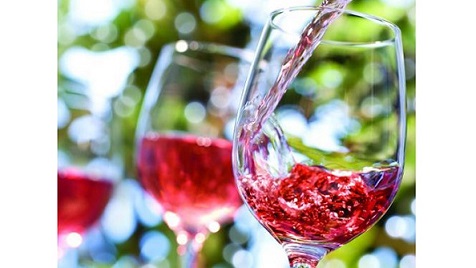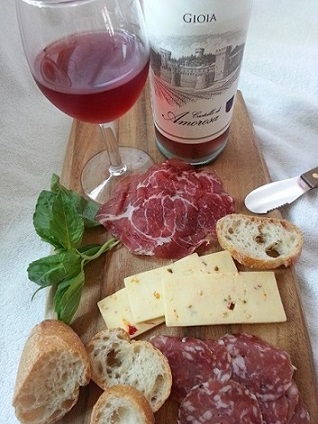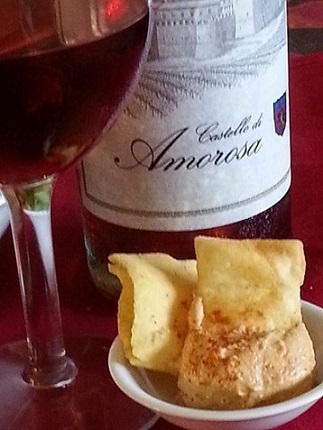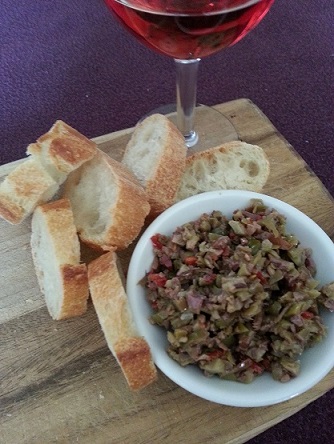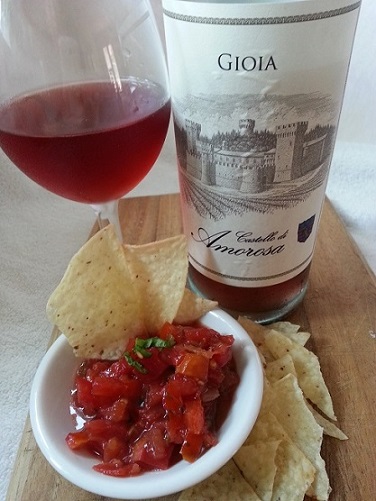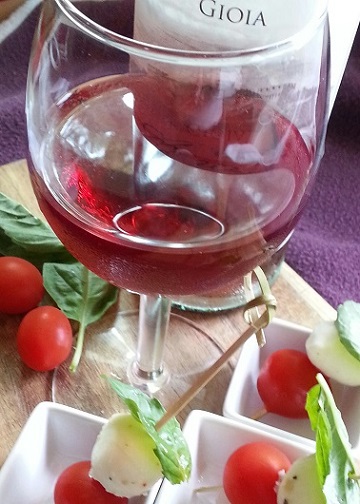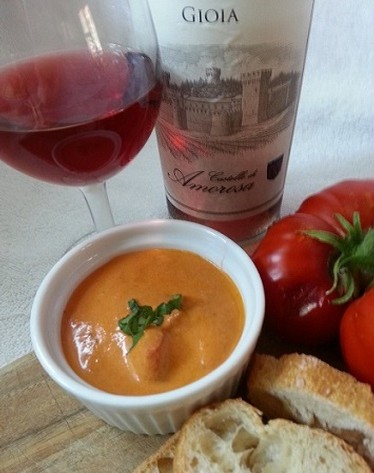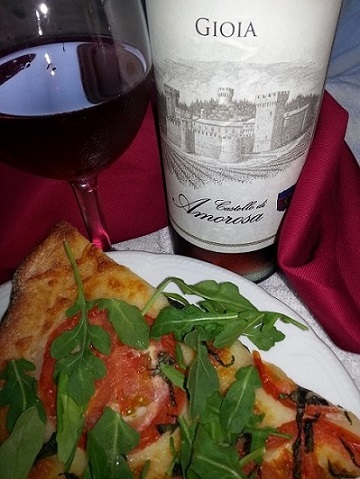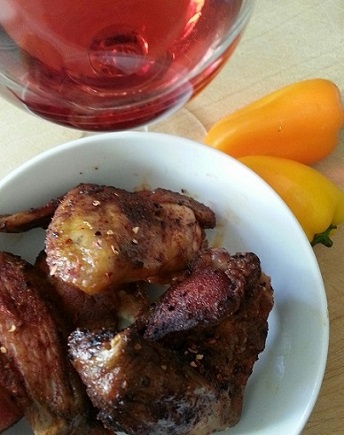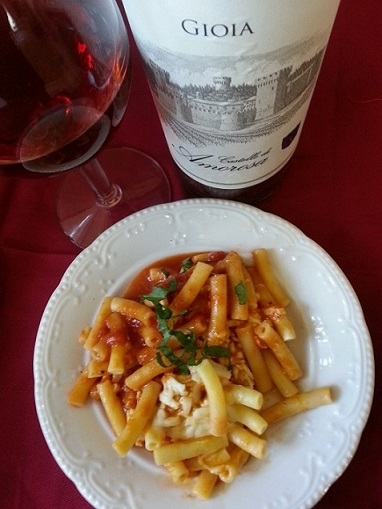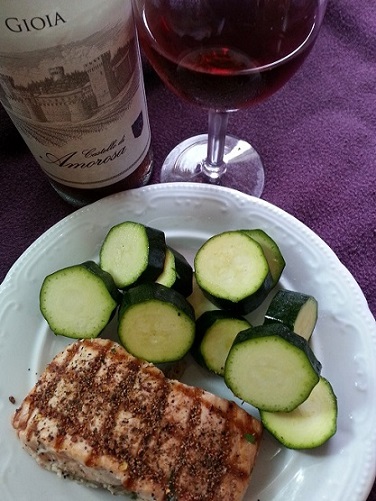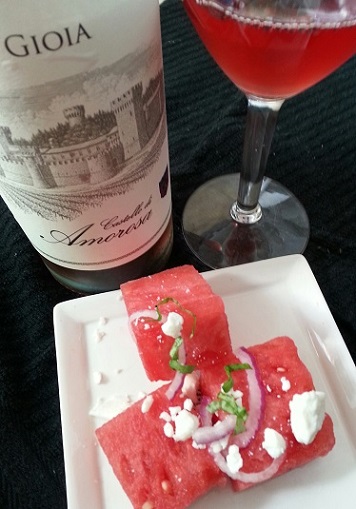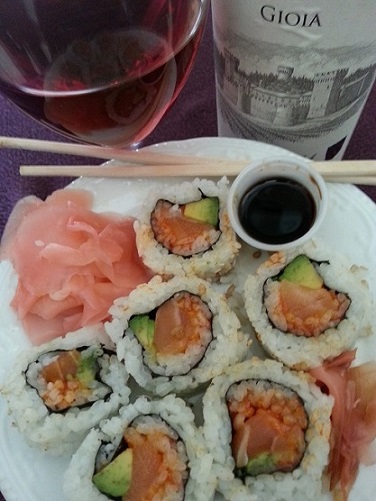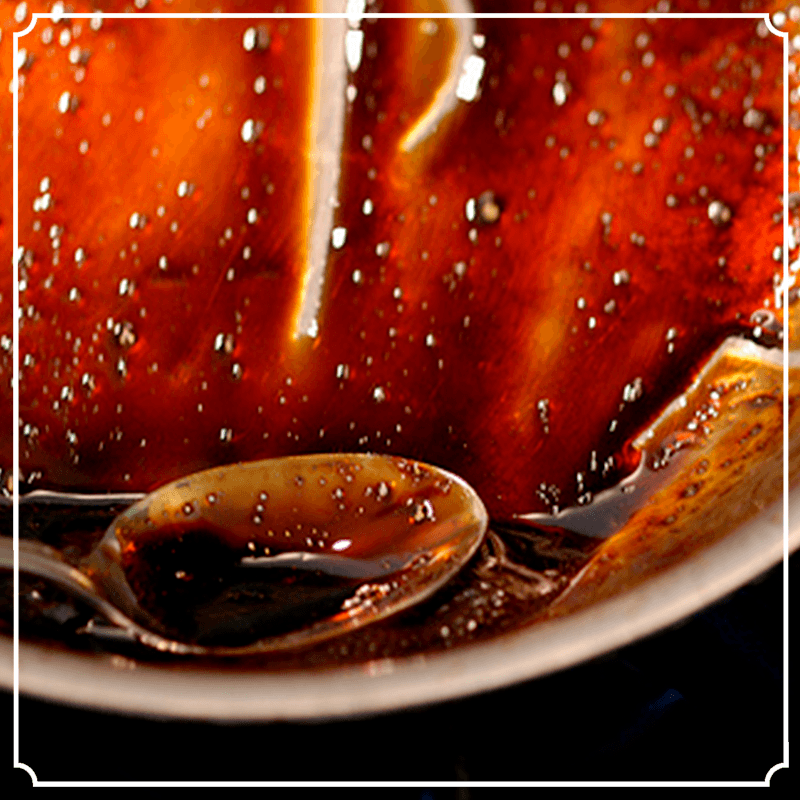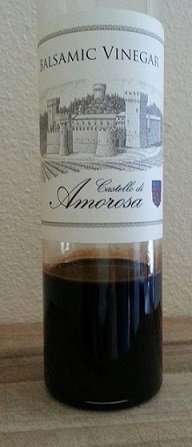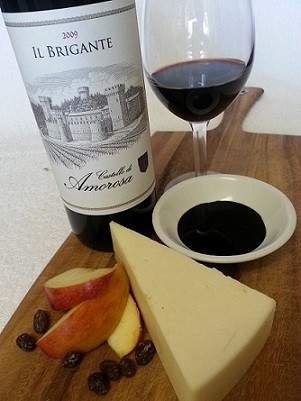A 'Season To Taste'

Mary Davidek
A season to taste
I am a cooking and food magazine junkie. It all started with my Mom and a ritual that took place during our visit to the ‘beauty parlor’ (not a salon, but the beauty parlor!) for Mom’s weekly scheduled shampoo and set. Here she regularly scoured through the latest edition of ‘Family Circle’, ‘Good Housekeeping’ and ‘Sunset’ magazines and recited recipes in a much too loud voice so I (and everyone in a 20 yard radius) could hear her over the constant noise generated by the mission control-like dryer chair. I would nod with dutiful approval dotted with an intermittent ‘yep, sounds good’ which were typically enough to satiate her. To add to her enjoyment and proof I really was listening, I even managed to insert a question or two; “what is braising?” or “why does it have to be sifted?” This launched her into an explanation that today seems worthy of ‘Food Network’. However, one particular phrase seemed to arise on nearly every recipe and always required definition and clarification — “season to taste”.
Mom explained the following:
Add salt until it you taste it. If it seems bland- it probably is. Increase by a ¼ tsp. and taste after each addition.
Add seasoning and spices (pepper, fresh herbs, dried seasoning) until the taste is in balance with the rest of the flavors. Make sure spices and seasonings cook along with the dish. However, additional fresh herbs added at the end can make a big difference.
Add acid (Tabasco, lemon juice, or vinegar) if it tastes flat or one-dimensional. Hot sauce works in creamy dishes because the acid from the vinegar and the heat from the peppers boost the flavors. Keep a light hand; if the dish isn’t supposed to be “spicy hot” add just a splash of hot sauce then use vinegar or lemon juice.
Add sugar; the tried and true fix if you overdo it. Sugar balances both salty and bitter flavors. Adding a touch of sugar makes too salty taste less salty and too bitter or sour taste less bitter without actually decreasing the amount of salt or acid in the recipe.
The thing is, Mom’s beauty shop narrations were not idle or forgotten ideas of an affordable casserole or a quick and easy dessert, they were her inspiration for future meals and goodies that made it to the family table and eventually led to my life-long pursuit of ‘tasting’.
Here is one of my cold-weather favorites. It is hearty, spicy, savory and comforting; ideal to keep in the fridge and warm up after a day of visiting with friends and family or after hours of wrapping followed by seconds of unwrapping. Remember always adjust the spices as you progress and as in all recipes—season to taste!
I wish you perfectly seasoned greetings–
Happy Holidays!
Mary Davidek
Deconstructed Albondigas
Ingredients
- 4 Cups Beef Broth
- 4 Cups Chicken Broth
- 2 large cans crushed tomatoes (28 oz.)
- 2 large cans diced tomatoes
- 1 lb. ground beef
- 1 lb. spicy sausage
- 2 heads of cabbage, cored and diced
- 1 small bag frozen white corn
- 4-6 carrots thinly sliced
- 4-6 stalks diced celery
- 4 large cloves minced garlic
- 1 bunch of chopped cilantro (set some aside for garnish)
- 1 large diced brown onion
- Season to taste =)
Directions
Brown ground meat and/or sausage. Add to a large pot with all other ingredients. Cook over medium low heat until vegetables are to desired softness. To accelerate the cooking process, give the veggies a quick sauté before adding to the pot. Stir and taste often and, as always, add seasoning as needed.
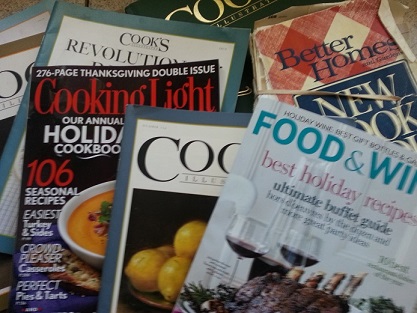
My current library. The Better Homes and Garden cook book was a wedding gift from who else; my Mom. Held together by a rubber band, for 24 years I have referred to this book filled with hand written notes and recipes.
‘Deconstructed’ is contemporary food lingo but Mom would have just said this was quicker and easier than making and cooking meatballs! This is tasty and easy to reheat during the upcoming week of merriment or freeze leftovers in containers for up to 6 months.
Dry, crisp and almost exotic; Castello di Amorosa’s Anderson Valley Gewurztraminer balances the spice and works with the richness of the ground meat and sausage. Perfect for a first course or as a hearty meal served with fresh bread or warm tortillas.
Raise a Glass! How Will You Celebrate 80 Years of Repeal?

Mary Davidek
Raise a Glass to Repeal Day! The End of Prohibition in the US
The turn of the twentieth century was indeed a dark (and dry) time in American history. Organizations like The Women’s Christian Temperance Union, which promoted Prohibition, believed alcohol to be the cause of most social ills. On January 16th, 1919, Congress passed the 18th Amendment, outlawing alcohol thereby putting an end to drunkenness, crime, mental illness, and poverty. (Ahem!)
Ironically, during Prohibition, America’s thirst increased. Organized crime rose to replace formerly legal methods of alcohol production and distribution. Ultimately, respect for the law diminished and drunkenness, crime and resentment of the federal government prevailed. Over the course of the next thirteen years, support for Prohibition waned as the nation awoke to the widespread problems Prohibition caused. The number of repeal organizations increased, and in 1932 Franklin D. Roosevelt ran for President on a platform that included the repeal of Prohibition. He won that race and on December 5th, 1933, Pennsylvania and Utah, the final states needed for a three quarters majority, ratified the 21st Amendment, repealing Prohibition and restoring our right to a celebratory drink. The 18th amendment remains the only amendment to our Constitution to ever be repealed.
On December 5th we celebrate Repeal Day and the end of prohibition in the US because it marks a return to the rich traditions and enjoyment of alcohol as a sacred and protected social custom. Conveniently located between Thanksgiving and Christmas, Repeal presents the perfect occasion to gather with friends and celebrate! Unlike St. Patrick’s Day or Halloween Repeal is a day we can all share in observing; it’s written in our Constitution.There are no outfits to buy, costumes to rent, or gifts to wrap. Simply celebrate Repeal Day by enjoying a glass of wine with a loved one.
Raise a glass!

The 18th Amendment
Ratified January 16, 1919
Section 1. After one year from the ratification of this article the manufacture, sale, or transportation of intoxicating liquors within, the importation thereof into, or the exportation thereof from the United States and all territory subject to the jurisdiction thereof for beverage purposes is hereby prohibited.
Section 2. The Congress and the several States shall have concurrent power to enforce this article by appropriate legislation.
Section 3. This article shall be inoperative unless it shall have been ratified as an amendment to the Constitution by the legislatures of the several States, as provided in the Constitution, within seven years from the date of the submission hereof to the States by the Congress.
The 21st Amendment
Ratified December 5, 1933
Section 1. The eighteenth article of amendment to the Constitution of the United States is hereby repealed.
The suggested pairing for your Repeal Day celebration!

Make Black Friday 'Red'

Mary Davidek
Make Black Friday ‘Red’
For millions ‘Black Friday’ means time to do serious Christmas shopping –even before the last of the Thanksgiving leftovers are gone- shopping routes are planned and parking strategies formulated. The Friday after Thanksgiving is one of the major shopping days of the year. Dating back to the start of the Macy’s Thanksgiving Day Parade in 1924, the Friday after Thanksgiving has been known as the unofficial- official start to a bustling and prosperous shopping season.
The term ‘Black Friday’ was coined in the 1960s to mark the kickoff of the Christmas shopping season referring to stores moving from the ‘red’ to the ‘black’. Of course, this was when accounting records were kept by hand; red ink indicated a loss and black ink showed a profit. Retailers began to realize they could draw big crowds by discounting prices and ‘Black Friday’ became the day to shop bringing with it even better deals than last minute Christmas sales. Many retailers now open at 5 am or earlier(!!!) to hoards of people waiting anxiously outside.
However, more and more consumers are choosing to shop online, not wanting to wait outside in the early morning chill with the crush of other shoppers or a battle over the last most-wanted item. Online shopping is easy, dependable and with the many shipping specials and pricing incentives—the deals are hard to beat. Now this is where the red comes in…pour a big glass and let the bargains begin! It’s the only way to shop!
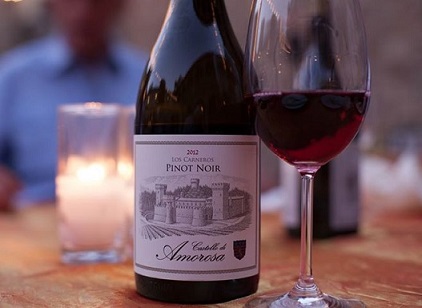
Castello di Amorosa’s Black Friday special!
All the Right Stuffing

Mary Davidek
All the Right Stuffing: Recipe and Wine Pairing for Thanksgiving
My first attempt at preparing Thanksgiving dinner sans mother was in 1995, a rite of passage. This particular meal was not a small intimate dinner for myself and my husband, this feast included 2 harsh scrutinizing critics; my step children.
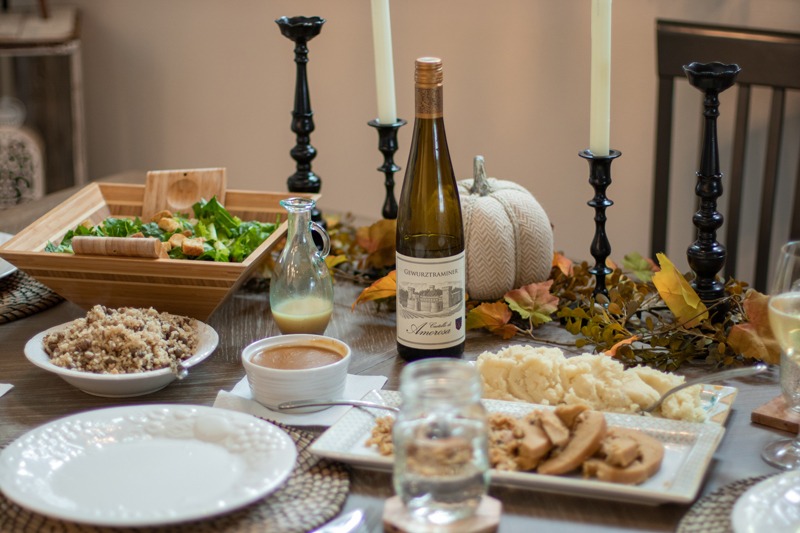
We rented a cabin near Lake Tahoe as we thought it would be the ideal setting for a mountain holiday. The prospect of a Turkey day snowfall and a warm fire seemed perfect. Unfortunately, my mother hurt her leg 3 days before the trip which left more than travel arrangements to rearrange, she was chef de cuisine!
Finally, Thanksgiving Day arrived which meant the inevitable trip to the grocery store, but first, a phone call to Mom. Amidst tears (mine), frantic note-taking (me), and some tricks (hers) I was set to create a yummy meal. With the list in hand, including the deal-breakers (nothing with carrots, nuts, or mushrooms for Mikaela and for Philip; no peas, cauliflower, or squash). *sigh*… off to the market.
I bought more than was necessary but I was in no position to make last-minute shopping trips, this was a one-time performance. Turkey breast; check. Wine; got it. Yams, mashed potatoes; easy. Wine; yes again. Gravy; not too difficult. Biscuits, the kids love little crescent rolls. Pie and whipped cream, double-check. Wine; yes, will need a 3rd bottle. But (cue Jaws theme) what about the stuffing?! The very stuff of which Thanksgiving can be made or broken. I got the stuff for everything else but the stuffing! And my Mother‘s stuffing was the benchmark, the Alpha, the Omega of stuffing. Turkeys were honored to be served with this stuffing. How could I have forgotten such a fundamental Thanksgiving Day dish? After all, I had watched her make stuffing for almost 30 years! That’s 30 Thanksgiving dinners! Wait…um….er…..yes. Ok, thanks Mom, I got this.
We sat cross-legged at the coffee table in the middle of a cozy living room, a fire was crackling and the snow was falling. Thanksgiving Dinner 1995 garnered rave reviews, the critics were delighted and the stuffing recipe was just right. Happy Thanksgiving!
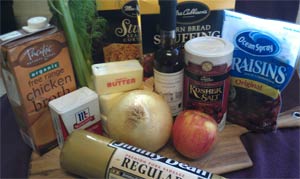
Some very traditional ingredients plus a few additions: cornbread stuffing mix, broth, butter, salt, pepper, sweet onion, apple, fennel, dried cranberries, salt, pepper, grape seed oil, and sausage. Lean turkey or chicken sausage is usually my preference, but for stuffing, I want the extra richness of pork sausage.
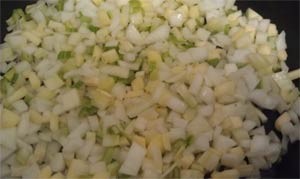
Sauté onion, fennel, and apple in grapeseed oil. Grapeseed oil brings complex fruitiness and is great for sauté. If available, use fennel instead of celery, it has a sweetness that compliments the onion and tart apple. This sauté has incredible aromatics.
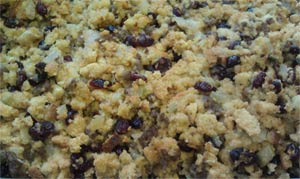
I prefer cornbread but any stuffing mix will work. Add dried cranberries for a splash of color and a hint of acidity. Mix with browned sausage and sautéed veggies. Add melted butter and broth per instructions increasing broth amount by 1/5th. Bake at 350°F for approximately 40 minutes, remove foil and bake an additional 5 to 10 minutes.
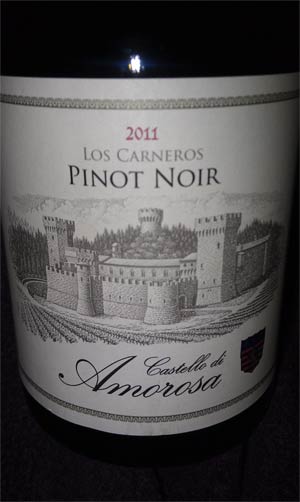
Pinot Noir and Thanksgiving are a given at my table but with the abundance of savories, it is hard to decide on a style of Pinot most suited for the big feast. Castello di Amorosa Los Carneros Pinot Noir is on the lighter side of the Pinot Noir spectrum, perfect for turkey and all the trimmings. Seductive notes of mulled spice on the nose and a mouthful of bright fruit will complement the entire spectrum of Turkey Day dishes. To make this Pinot pop, serve at 62 to 65°F.
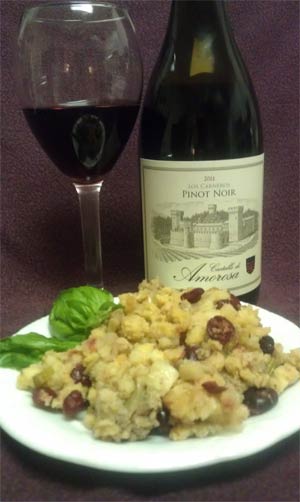
Happy Thanksgiving!
In Defense Of Napa Valley's Veteran Wine Hero

Mary Davidek
In Defense Of Napa Valley’s Veteran Wine Hero
I was at a dinner party a couple of weeks ago and the subject of Napa Valley wine came up – I realize this is not shocking nor in itself blog-worthy! However, at this dinner we were specifically discussing Chardonnay. Maybe it was the time year as Chardonnay was the grape harvest du jour. Maybe it was the company I was in; long time Napa locals and wine makers. Maybe it was the wine I brought for the occasion.
This was mildly ironic as not more than 8 years prior I attended an ABC dinner, an entire night of Anything But Chardonnay. Admittedly, I was a reluctant participant but I attended *sigh* and took part in the grape bashing. “Too oaky!” claimed one reveler. “Manipulated and contrived” cried another! My favorite denial of this classic varietal was “Chardonnay does not pair well with ANY food!”
Wow–quite a statement! However, to put it bluntly; they were wrong.
It is now a number of years later and we are approaching Veteran’s Day. In America, this day is reserved as a time to reflect and celebrate past heroes and champions. Perhaps wine lovers should follow suit and pay respect to one of America’s wine heroes. After all, it was a California Chardonnay that won the 1976 Paris tasting and brought recognition and eventually fame to a small farming community; Napa Valley.
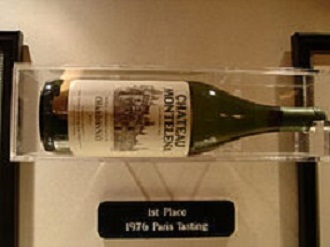
Chardonnay is the second most planted white wine varietal in France and remains the most planted white wine grape on the planet. Additionally, Chardonnay styles differ dramatically and can reflect the artistry of wine making; buttery and oaky, crisp and fruity, austere with minerality. Combined with the diversity of soil and climatic zones, Chardonnay exhibits varied complexities and offers ageble wines with broad appeal. Plus, in the last 20 years wine makers have found malolactic fermentation and oak ageing are winemaking tools, but don’t have to be used fully, or at all, with every Chardonnay.
I regret my brief slide into the ABC movement. While our preferences may change as we explore different growing regions, varietals, and styles of winemaking; it is important to stay open-minded and savor new discoveries. And sometimes, we just have to stick to our guns and defend tried and true veterans that brought victory to the field and eventually… to our glass!
Chardonnay is primarily fermented in oak and is aged sur lie or on the lees. Lees refers to deposits of residual yeast and other particles occurring during fermentation. Ageing sur lie softens the taste of Chardonnay, especially on the finish. Oak provides oils and resins which not only add to the overall flavor and character of the wine but make Chardonnay a white wine which can benefit from bottle ageing.
The 2007 Napa Valley Chardonnay has become ripe and juicy with golden apple, comice pear and lightly toasted brulee. If you have any of this Castello beauty hiding in the corner bring it out this Thanksgiving! Enjoy with a hearty harvest salad garnished with candied pecans and crumbled Feta
The 2008 Castello di Amorosa Bien Nacido Chardonnay knocked my proverbial wine-socks off! At five years from vintage this was visually beautiful and simply stunning in the glass. Vanilla and spice were the words repeated again and again, however, the 2008 Bien Nacido retained its fruit and was vivid on the palate.
Chardonnay may not be the traditional go-to for Ahi salad, but, a bit of ageing leveled off the acidity and the velvety texture of the avocado played off the creamy notes of the Chardonnay. This was a delicious and luxurious pairing.
Ahi and Avocado Salad with Ponzu 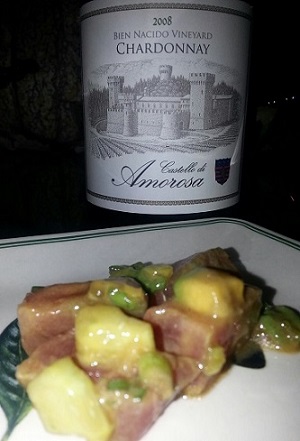
- ½ cup ponzu or soy sauce
- 3 Tbsp. water
- 2 Tbsp. rice vinegar
- 1 Tbsp. grated ginger
- 1 thinly sliced green onion
- 1 ½ tsp. lime juice w/ zest to taste
- Mix well and pour over cubed Ahi and Avocado
Silence of the Lamb Shanks

Mary Davidek
Silence of the lams shanks
In all honesty, Halloween has never been my favorite holiday. I don’t have a sweet tooth, I never liked to dress in costumes and fright movies terrify me. With three older brothers I was often the victim of pranks and shenanigans and I am quite certain my irrational fear of monkeys and primates can be traced to the mischief my brothers concocted which turned grade school trips to the zoo into angst ridden rituals. The only aspect of Halloween I truly warmed to was the fact that traditionally Halloween marks the beginning of the holiday season. Fall and winter vegetables replace summer fruits and the conspicuous cornucopia of harvest prevails. Bring out the blankets and smell the spices wafting in the chilled autumn air.
I know, I know… it’s Halloween and fright-night festivities may be on the agenda; perhaps not a trick-or-treat outing but maybe a cozy dinner party with a few friends followed by a few favorite movies. And just because it’s a holiday spotlighting pumpkins and candy corn does not mean we should throw thoughts of food and wine pairing to the jack-o-lantern! Take a cue from one of the most ominous and frightening movie monsters in history, move over Freddy and Jason—Hannibal Lecter gets my vote for Halloween’s classic scary movie poster- boy! Hannibal is creepy, petrifying and unnervingly disturbing and yet even while shackled in chains and full facial restraint he maintained a pompous arrogance. This notorious villain has one quality I can’t fault; he certainly cared about pairing his meals with the correct wine! *ahem* Plus, he obviously loves vino Italiano which makes Hannibal Lecter Castello di Amorosa’s gruesomely detestable official “Fright Knight’.
Savor this Halloween with a delicious and super easy comforting classic — replete with fava beans and a nice Chianti…. (Sangiovese, of course!) Pop in a DVD and enjoy…..
Silence of the Lamb Shanks!
♦ Easy Crock Pot Lamb Shanks
Brown Lamb Shanks in grapeseed oil in large pan
Season generously with Salt and Pepper
Place browned shanks into crock pot and top with the following:
- 1/2 C red wine
- 1/2 C beef stock
- 1 can (14 oz) Italian style diced tomatoes
- 1 tsp Italian Seasoning
- 8-10 cloves of diced garlic
- 4 large sliced mushrooms
- 1 TBSP Worcestershire
- 1 sweet onion cut into large slices
Place crock pot on low 6 -8 hours, remove shanks and plate with sauce and vegetables
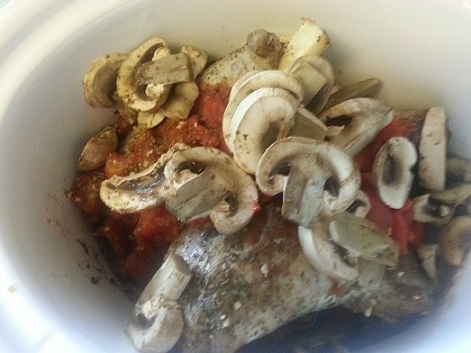
Mushrooms, tomatoes, garlic, broth and red wine create a delicious sauce.

Sangiovese, the primary grape grown in the Chianti region of Tuscany, is a very important varietal at Castello di Amorosa. Sangiovese also provides a spine of bright red cherry in blends like Il Brigante and La Castellana.
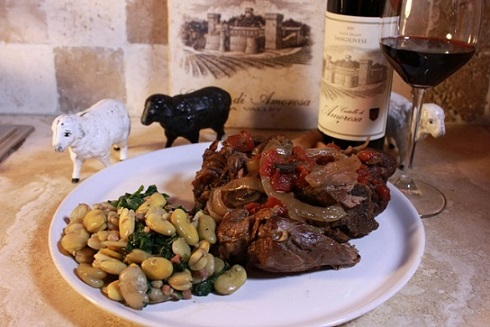
The Silence of the Lamb Shanks, fava beans, and a nice ‘Chianti’ in true Castello style!
Happy Halloween!
Grape Seed Oil- Enlightened

Mary Davidek
Meet Mary
Grape Seed Oil Process – Enlightened
For the last 19 months, I have been on a journey of more healthful eating. This has included only small quantities of lean meats with most animal proteins in the family of fish and fowl. Most of my daily caloric intake comes from fiber via fruit, vegetables, nuts and whole grains. I thought I was doing great; losing pounds, gaining stamina….I felt renewed…invigorated… healthy. However, while a high-fat, high-calorie diet increases the risk of gallstones, apparently a very low fat weight loss plan can also cause issues. While a low fat diet allows you to lose weight, with smaller quantities of fat and oil to break down, the gallbladder does not contract or empty as frequently, and, as a result, this may produce a build-up of bile and possibly an increased risk of gallstones.
With my gallbladder permanently out of the equation, I’ve taken time in the last few weeks for a little research…. along with a little lab work (i.e. cooking in the kitchen) in an effort to repair my relationship with fats and oils.
Oils are fats that are liquid at room temperature. Although oils are not a food group, they provide essential nutrients and are therefore included in USDA recommendations of what to eat. Most fats should be polyunsaturated (PUFA) or monounsaturated (MUFA) fats. Oils are the major source of MUFAs and PUFAs in the diet.
My research eventually took me to an article published by Bon Appétit. Who better than the good eating experts to help guide me in my search for healthy and tasty oil? “Some fat is actually good for you,” the article quotes Alice H. Lichtenstein, director of the cardiovascular nutrition laboratory at Tufts University. “But, to get the most from fats, you need to go beyond olive oil. Open your cupboard to new flavors, cooking temperatures–and health benefits–by diversifying your oils.” In the number one position of most healthful oil on Bon Appétit’s list—grape seed oil! High in polyunsaturated fats and vitamin E, grape seed oil has a high smoke point, which makes it a good substitute for olive or vegetable oils for a sauté or stir-fry, and because it has light and clean flavors on the palate, it lets top-notch ingredients stand out.
I remain diligent when it comes to healthy eating and food choices. However, as a discerning skeptic my cynical tendencies combined with my resistance to change has always played second string to the great equalizer; taste! Donning a lab coat for this foray instead of an apron, I must experiment. I made a few fairly standard favorites where I traditionally used olive oil and substituted grape seed oil.
The results were en-lightening!
The process begins on the conveyor for these yummy clusters. Ready to go into the hopper where the stems will be separated and then composted.
Although we are a world of organic goals, long term sustainability is realistic and achievable now. The stems are separated from the clusters and prepared for composting and provide vital nutrients in the vineyard.
After fermentation and a final press of the skins, the pumace is taken and the seeds will be separated and dried.
. 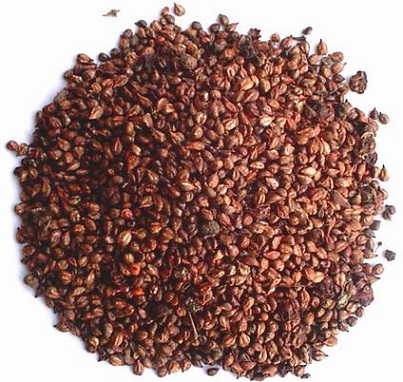
After several months, the dried grape seeds are ready to be pressed and oil is extracted from the seeds. The oil is obtained through pressing and grinding seeds with the use of stainless steel presses. Since grape seeds are discarded as part of the wine making process, the extraction of the oil is an efficient and sustainable use of a byproduct.
The best oils are cold pressed. Although pressing and grinding produces heat through friction, the temperature must not rise above 120°F for any oil to be considered cold pressed. Cold pressed oils retain their flavor, aroma, and nutritional value. Sample cold pressed grape seed oils at Castello di Amorosa on the Royal Food and Wine Pairing tour.
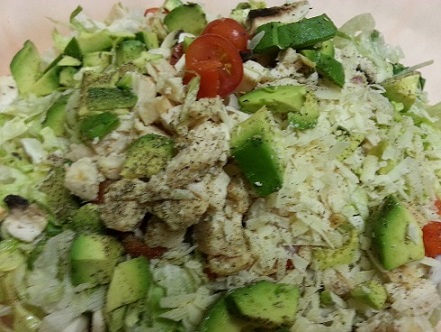
Since grape seed oil is lighter than olive oil, I was having a problem with a pool of oil accumulating at the bottom of the salad bowl. Problem solved; when making salads, I now add the seasonings and toss it which coats the lettuce with the seasoning giving the oil something to adhere to. Light, healthy and the lettuce retained its crispness.
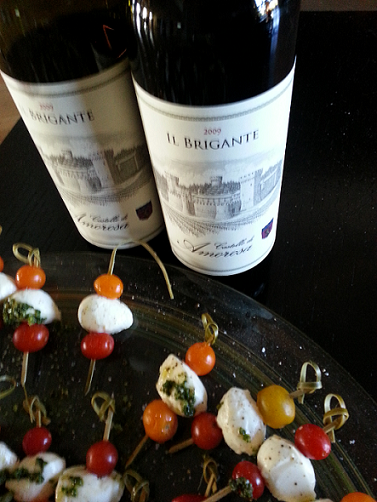
I drizzled a little Sauvignon Blanc grape seed oil and basil on the bruschetta bites—delicious!
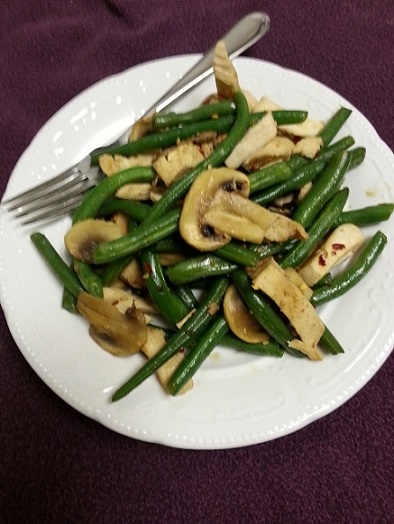
Stir fry and sautés are my favorite use of grape seed oil. Since grape seed oil has a higher smoking point than olive oil, veggies and meat are added to a hotter pan. Plus, the grape seed oil gives off very little flavor in a sauté and this really lets the ingredients shine.
Bring on the Pig-ment-Skin

Mary Davidek
Bring on the Pig-ment-Skin
As summer comes to a close and long hot days become abbreviated and alleviated with cooler temps and sweater worthy evenings–September is here. With it, the beauty of harvest and fall is underway. Undeniably my favorite time of the year; the anticipation, the realization of another season. Nervously…… we wait. The hopes, the expectations— will it be as good as last year? Will this year bring the success of another triumph? Will we get the points and revel in great scores? It has finally arrived.
That’s right… are you ready for some football!?
Regular season NFL starts this week and the pigskin is finally back in action. Of course, while the football is being passed and punted on the gridiron the red zone has officially been crossed at my house. Bring on the pigment!
All wine grapes contain clear juice. Although there are a few varietals with tinted juice it is extremely rare. Red wine becomes colored or pigmented in the winemaking process. The liberated or pressed juice of black grapes are fermented in contact with the skins. Since the skins contain all the color, fermentation with the skins extracts this color to the juice and resultant wine. The skin of black grapes also contains complex elements that not only result in this pigmented juice, but imparts tannins and many healthful antioxidants.
My match-up this week includes Cabernet Sauvignon; and since it doesn’t get much more pigmented than this thick-skinned varietal… well….. this pairing calls for a pepper spiked little pig of my own to mark the occasion.
Cheers, or as they say on the field—get ready for kickoff!
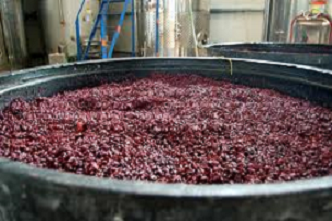
No need for binoculars! View this action live and in person from the proverbial 50 yard line! Fall is the time of year for a trip to wine country. Watch the winemaking process from Castello di Amorosa’s home field, the crush pad!
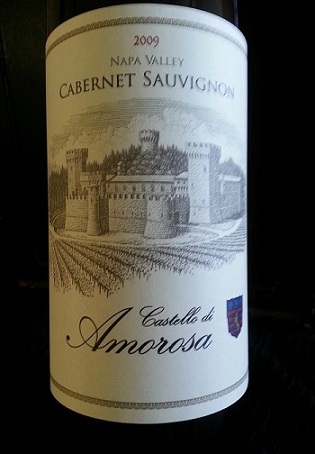
Talk about score! Robert Parker gave Castello di Amorosa’s 2009 Cabernet Sauvignon 91 points! This 100% Cabernet Sauvignon is brawny with loads of muscle yet exhibits a graceful and elegant mouth feel. Brooding deep dark fruit with a hint of spice box and black pepper. Touchdown!
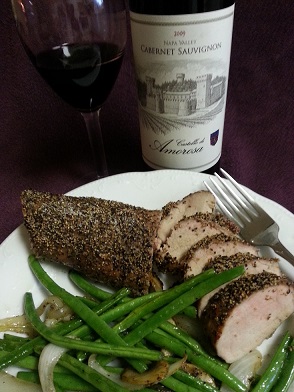
Simple, quick and delicious. This meal won’t keep you away from important plays! I sprinkled the tenderloin with sea salt and garlic powder then very generously coated it with coarse ground pepper. Bake at 350 degrees until the center of the loin reaches 150 deg. Let rest for 10-15 minutes before serving. The peppery seasoned tenderloin plays off the dark fruit of the Cabernet. After Sunday’s match-up this makes for incredible sandwiches to enjoy the next night…during Monday Night Football!
Rosé - A Dozen Pairings Picked

Mary Davidek
Meet Mary
Rosé – A Dozen Pairings Picked
If you’ve attended the Royal Food and Wine Pairing at Castello di Amorosa it comes as no surprise –you know my affection for Gioia, Castello di Amorosa’s Rosato of Sangiovese. Perhaps one of the most versatile food wines available as the pairing possibilities for a well-made rosé are seemingly endless. Traditionally, rosé wines are dry, light, and fruity and carry appeal for white and red wine drinkers. Any black-skinned grape can be made into a blush or rosé wine. The longer the skins remain in contact with the juice and pulp, the more pigment is imparted and, thus, the redder the juice or wine becomes. Rosé is produced by limiting the contact of the skins of black grapes with the juice; for Gioia, it is approximately 36 hours. As we weather the dog-days of summer and celebrate with picnics, grill parties and backyard entertaining, Rosé indeed seems to be on everybody’s mind…and palate. This is a perfect opportunity to explore the aforementioned ‘pairing possibilities’.
Let’s put my theory to the test…let the rosé wine pairings begin!
Castello di Amorosa’s Gioia, Rosato of Sangiovese has a bright and beautiful salmon colored hue. Serve this chilled rosé with tasty apps or a light and seasonal dinner.
Full-bodied rosé wines are a great match for terrines, pate, and Italian salumi. The fruit notes of Gioia compliment the gamey meats and the acidity provides just enough ‘zip’ to cut through the fattiness of these tasty selections.
Roasted red pepper hummus is a yummy app with a chilled rosé.
Olive-based tapenades with anchovies, capers and light vinegar are prolific in Italian cuisine. The saltiness of the olives is a perfect back drop for fruity Gioia.
Forget the margaritas! Salsa provides a hint (or a lot!) of spice—cool crisp Gioia with the tomatoes and cilantro atop a salty tortilla chip is delicious. Yo tengo chips and salsa!
No time to make a caprese salad..no problem. Caprese bites are a quick and easy alternative.
A favorite on the Royal Food and Wine Pairing menu, cream of tomato basil soup. A touch of cumin adds Mediterranean flair and chilled Gioia is a refreshing contrast to this warming comfort soup.
Margherita Pizza is named for the first Queen of modern Italy, Margherita De Savoia-(l85l-l926). Margherita pizza is a thin crust pizza with tomatoes, mozzarella and basil. For a peppery freshness, try it topped with leaves of arugula. Thank you Queen Margherita, you would have loved this pizza with Castello’s Italian style Rosato of Sangiovese, Gioia.
Hot wings and Gioia was my husband’s favorite pairing. This duo takes me back to circa 1985 ordering buffalo wings and a bottle of chilled white Zin! I was definitely on to something—fruit and spice makes everything nice!
Pasta with marinara sprinkled with Asiago and served with Gioia was a simple meal on a hot summer evening.
Research suggests that eating oily fish once or twice a week may increase your lifespan by more than two years and reduce your risk of cardiovascular disease up to 35 percent. That combined with a relaxing glass of wine and we may have found the fountain of youth! I loved the grilled smokiness of the delicate salmon meat which was complemented by the crisp berry burst of Gioia. This healthy pairing was incredible; grilled sockeye salmon from our friends at Great Alaska Seafood http://www.great-alaska-seafood.com
A cool watermelon salad tossed in cold pressed grape seed oil and light vinaigrette. Flavorful red onion and a few crumbles of feta combine for a surprising palate of sweet, salty and tangy. Castello di Amorosa’s Gioia completed this palate of fruity crispness.
Kanpai! Talk about a mixed marriage! Rosé is a natural for exotic spices.
Reductions ... Simplified

Mary Davidek
What Is a Reduction in Cooking? | Balsamic Vinegar Reduction
What is a reduction in cooking? The dictionary defines reduction as the act or process of reducing. This is concise and fairly straightforward. In the kitchen, reductions are equally concise and straightforward. Reducing is simply the process of thickening a liquid i.e. soup, sauce, wine etc. by heating. This slowly causes evaporation thereby intensifying the flavor of the liquid. Using a pan without a lid is preferable (which allows the vapors to escape) until the desired volume is reached.
For this segment and by popular demand (Thanks, Rose!) I am going to specifically address balsamic vinegar reduction.
There won’t be much more except a note from personal experience. Reducing balsamic vinegar makes me look like a culinary genius (thanks, balsamic & heat!) and it is a great way to add richness, texture, and sweetness to savories and desserts. It elevates the ordinary.
As my grandmother said, “alla gioccia”.. good to the last drop!
Ready…. set…..reduce…..
Cheers!
Mary Davidek C.S., C.S.W.
Ingredients; just 1. A good balsamic need not be expensive. Castello di Amorosa balsamic is delicious and affordable at $18 per 500ml.
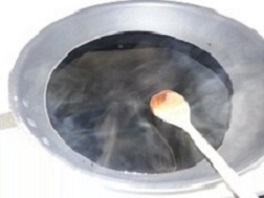
Reduce over medium-low heat to just under a simmer; approximately 195 degrees seems the optimum temperature. Use a large pan so the vapors can evaporate more rapidly. Increase stirring as it thickens.
500 ml or 17.25 ounces reduced to 4.5 ounces in slightly more than 1 hour. Store at room temperature or refrigerate for up to one year.
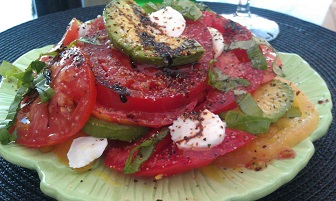
The perfect complement for a caprese salad.
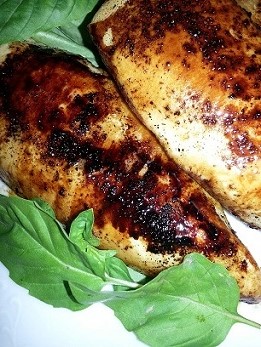
Baked chicken breast with balsamic reduction.
After removing the chicken from the oven, they were finished in the reduction pan which gave the chicken a delicious balsamic coating.
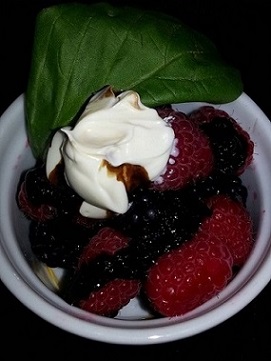
Berries drizzled with balsamic reduction topped with a dollop of fresh whipped cream. The acid in the berries evokes a dark chocolate note from the balsamic.
Firm cheese like Piave Vecchio or Pecorino dipped into a balsamic reduction adds just the right sweetness to these salty cheeses. The 2009 Il Brigante has a bit of Malbec which heightens the jammy notes of this cabernet blend.

This decadent dessert is a tasty surprise for the palate. Double dark chocolate gelato with balsamic reduction adds just a touch of savory. Sprinkle with salted almonds and all the bases of the palate are covered with this rich finale.

